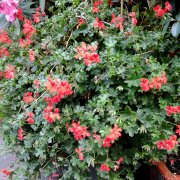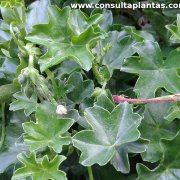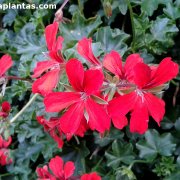Care of the plant Pelargonium peltatum or Ivy pelargonium |
|
The genus Pelargonium, family Geraniaceae, comprises 200 species of herbaceous plants, succulents and shrubs native to southern Africa. Some species are: Pelargonium peltatum, Pelargonium odoratissimum, Pelargonium graveolens, Pelargonium grandiflorum, Pelargonium exstipulatum, Pelargonium cucullatum, Pelargonium crispum, Pelargonium radens, Pelargonium zonale, Pelargonium tetragonum, Pelargonium quercifolium, Pelargonium magenteum, Pelargonium capitatum. Common names: Ivy pelargonium, Wild sorrel, Cascading pelargonium. This species is native to from Bainskloof to East London. They are perennial plants of hanging habit with thin and angular branches that reach 60 cm (23.6") in height. The leaves (similar to those of ivy) are fleshy, bright green and have 5 lobes. The showy flowers can be red, purple, lilac or pink. They can bloom from early spring to early fall. Ivy pelargonium is used in rockeries, borders, in hanging pots and in planters for patios, balconies and terraces. Pelargonium peltatum needs sunny exposure and warm temperatures. It resists light and occasional frosts. The soil can be a mixture of leaf mulch, peat, and siliceous coarse sand or a garden substrate drained with coarse sand and with a little manure or compost. Transplant every 1 or 2 years. Water frequently in summer (almost daily) and less in spring considering that Ivy pelargonium has some resistance to drought. In autumn and winter reduce watering without allowing the substrate to dry out completely. Fertilize in autumn or spring with compost or manure. Wild sorrel resists light formation pruning when flowering ends. Pelargonium peltatum is a plant resistant to pests and diseases. Ivy pelargonium is propagated from 20 cm (7.87") long cuttings in spring or summer. |
Images of the plant Pelargonium peltatum or Ivy pelargonium |
Find plants
Pelargonium peltatum or Ivy pelargonium | Care and Growing
© 2025 FavThemes


